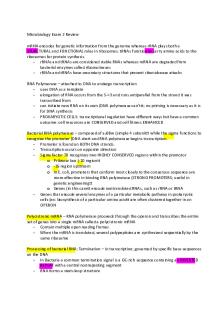FOOD Microbiology EXAM PDF

| Title | FOOD Microbiology EXAM |
|---|---|
| Author | Anonymous User |
| Course | Introduction to Food Microbiology |
| Institution | University of Reading |
| Pages | 4 |
| File Size | 124.4 KB |
| File Type | |
| Total Downloads | 65 |
| Total Views | 152 |
Summary
Examination for MSc...
Description
You are allowed ten minutes before the start of the examination to acquaint yourself with the instructions below and to read the question paper. Do not write anything until the invigilator informs you that you may start the examination. You will be given five minutes at the end of the examination to complete the front of any answer books used.
May / June 2006
FBM FM1 2005/6 A 001 1 Answer Books Multiple choice paper Section A Information Sheet for Question 3
THE UNIVERSITY OF READING Examination for MSc
INTRODUCTORY FOOD MICROBIOLOGY
ONE Hour
Answer ALL questions from SECTION A (Multiple Choice Paper) (ATTACH Section A paper to your answer book) and ONE question from SECTION B
Page 2 SECTION B (Allow 38 minutes for this section – 64 marks in total)
1.
Write notes on THREE of the following (equal marks for each part): (a)
Describe the properties of a typical bacterial cell. What characteristics of bacteria lead to them being a major cause of food spoilage.
(b)
Describe a suitable method for counting the viable Escherichia coli bacteria in a water sample (anticipated number, 5 bacteria per ml). Give your answer in the form of a flow chart of instructions suitable for a competent microbiological technician to follow. Your answer should demonstrate that your procedure will yield a valid result.
(c)
What kinds and concentrations (very approximately) of microbes would you expect to find in the following foods? Give reasons for your predictions. i) comminuted (minced) beef ii) freshly cooked rice iii) freshly prepared salad iv) yoghurt
(d)
With reference to the ecology and characteristics of Staphylococcus aureus, describe a typical sequence of events that may lead to cases of food poisoning by S. aureus. What measures can contribute to the prevention of food poisoning by S. aureus.
(e)
List four microorganisms that are used in the production of certain foods and describe the role(s) they play in the formation of flavours, textures, and other properties of specific foods.
Page 3 2.
Write an article suitable for the Reading Chronicle newspaper entitled: “BACTERIAL FOOD POISONING AND YOU: What you should know and what you should do” Remember that your article is for a general, scientifically relatively uneducated audience and, therefore, either avoid the use of or clearly explain the meaning of technical terms and jargon. Take care to explain the nature of bacterial food poisoning, how foods become contaminated, what the food industry and government does to try to reduce its incidence, and what your readers should do to reduce the likelihood of them contracting food poisoning. Turn over
Page 4 3.
Explain what is meant by microbial food spoilage. (10% of marks) What metabolic activities of microbes may lead to food spoilage? (20% of marks) What general approaches are available to reduce the rate of or inhibit microbial food spoilage? (15% of marks)
Information sheet supplied. i)
Calculate the concentrations (cfu ml-1) of psychrotrophic and lactic acid bacteria in the milk (15% of marks)
ii)
Predict the approximate shelf-life (i.e. the time to spoilage) of milk stored at 5 °C (given, mean population doubling times at 5 °C: psychrotrophic bacteria, 6 h; lactic acid bacteria, no growth; spoilage levels: psychrotrophic bacteria, 107 cfu ml-1; lactic acid bacteria 108 cfu ml-1). (15% of marks)
iii)
Predict the approximate shelf-life of milk stored at 20 °C (given, mean population doubling times at 20 °C: psychrotrophic bacteria, 3 h; lactic acid bacteria 1.5 h). (15% of marks)
iv)
Suggest what kind of spoilage the milk might undergo at each temperature. (10% of marks)
[End of Question Paper]...
Similar Free PDFs

FOOD Microbiology EXAM
- 4 Pages

Food Microbiology Third Edition
- 477 Pages

microbiology Exam
- 7 Pages

Microbiology first exam
- 7 Pages

Microbiology Exam 3 (Autosaved)
- 16 Pages

Microbiology Exam 2 Review
- 14 Pages

Microbiology Lecture Exam 2
- 4 Pages

Food production exam questions
- 3 Pages

Microbiology Exam 2 Study Guide
- 7 Pages

Exam 1- Microbiology Study Guide
- 23 Pages

FOOD EXAM Lecture
- 108 Pages
Popular Institutions
- Tinajero National High School - Annex
- Politeknik Caltex Riau
- Yokohama City University
- SGT University
- University of Al-Qadisiyah
- Divine Word College of Vigan
- Techniek College Rotterdam
- Universidade de Santiago
- Universiti Teknologi MARA Cawangan Johor Kampus Pasir Gudang
- Poltekkes Kemenkes Yogyakarta
- Baguio City National High School
- Colegio san marcos
- preparatoria uno
- Centro de Bachillerato Tecnológico Industrial y de Servicios No. 107
- Dalian Maritime University
- Quang Trung Secondary School
- Colegio Tecnológico en Informática
- Corporación Regional de Educación Superior
- Grupo CEDVA
- Dar Al Uloom University
- Centro de Estudios Preuniversitarios de la Universidad Nacional de Ingeniería
- 上智大学
- Aakash International School, Nuna Majara
- San Felipe Neri Catholic School
- Kang Chiao International School - New Taipei City
- Misamis Occidental National High School
- Institución Educativa Escuela Normal Juan Ladrilleros
- Kolehiyo ng Pantukan
- Batanes State College
- Instituto Continental
- Sekolah Menengah Kejuruan Kesehatan Kaltara (Tarakan)
- Colegio de La Inmaculada Concepcion - Cebu




